Mango Sago
Mango sago is a delightfully tropical dessert featuring ripe mangos and creamy banana slices in a tapioca pearl pudding. This better-for-you version of a classic Hong Kong dish uses coconut milk instead of condensed milk for a lighter, healthier, and dairy-free dish that’s great for beginner cooks.
Sago is a perfect summer treat for the whole family. Our unique method of cooking the tapioca pearls in milk creates a creamier texture than other recipes and elevates the flavor to another level!
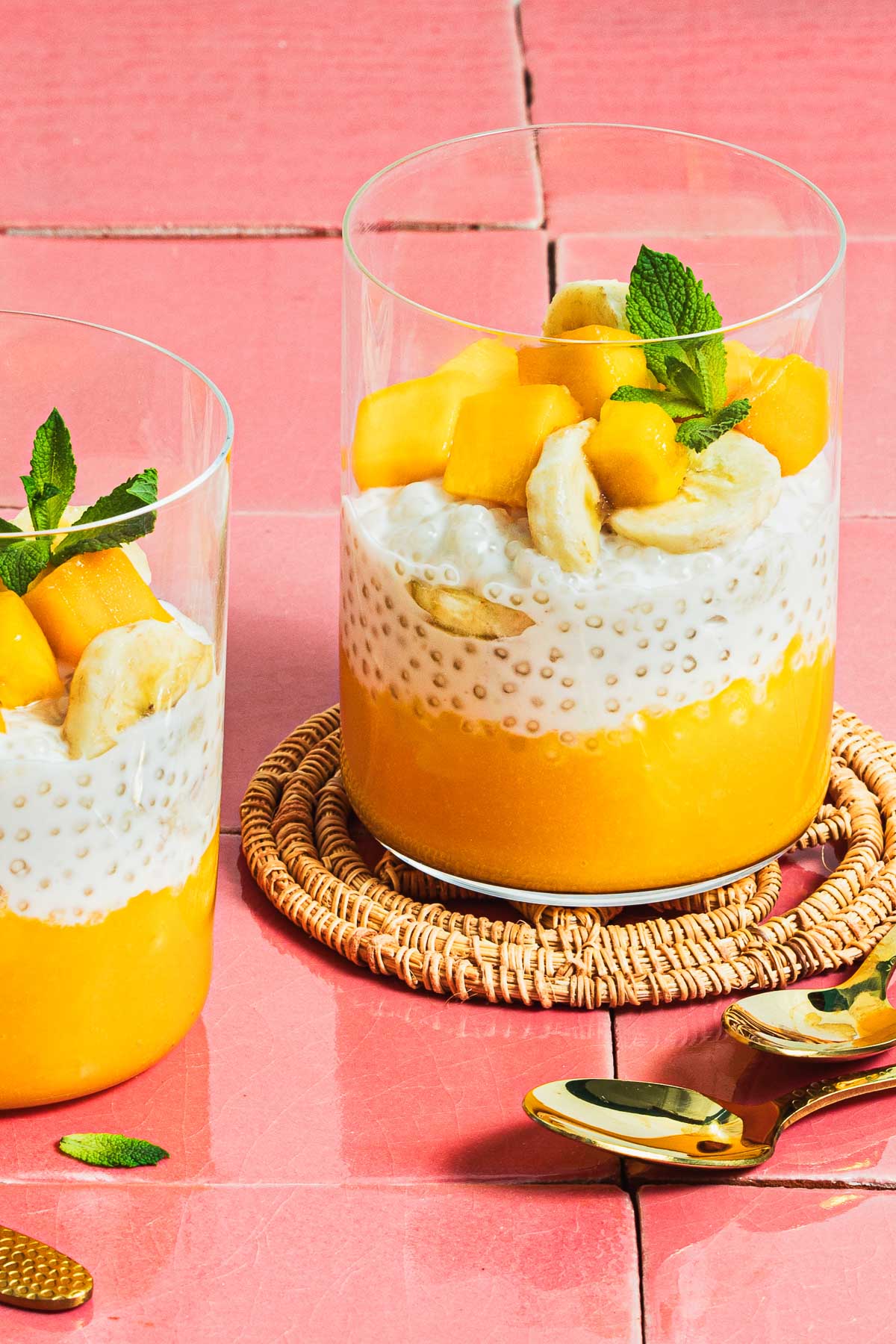
What is mango sago
Sago pudding with mango is a creamy and fruity dessert made with ripe mangoes, sago (small tapioca pearls), and a coconut milk base. It’s a delightful treat perfect for cooling down on a hot day.
Where is mango tapioca pudding from?
Mango Tapioca Sago is originally a Hong Kong dessert but is also popular throughout Southeast Asia, with variations in countries like Thailand, Vietnam, Singapore, and Taiwan. The Singaporean version often includes pomelo fruit and is called yang zhi gan lu.
What does sago taste like?
Coconut sago has a neutral taste, which means it absorbs the flavors of the ingredients it’s cooked with, making it a versatile addition to desserts.
What are tapioca pudding balls made of?
Tapioca pudding balls are made from the starch of the cassava root. They are shaped into small, tiny balls that become translucent and slightly chewy when cooked.
Our healthier version
Our mango sago recipe is healthier and lighter. Instead of using condensed milk, we use full-fat coconut milk. The tapioca pearls are simmered in dairy-free milk and coconut milk, resulting in a dessert that’s not too sweet but rather creamy, refreshing, and zesty.
Ingredients
This mango and coconut tapioca pudding will transport you to a tropical paradise! The combination of creamy coconut pudding, chewy tapioca pearls, and sweet fruit slices is heaven in your mouth. This recipe uses minimal ingredients and is so easy to whip up, making it perfect for novice cooks.
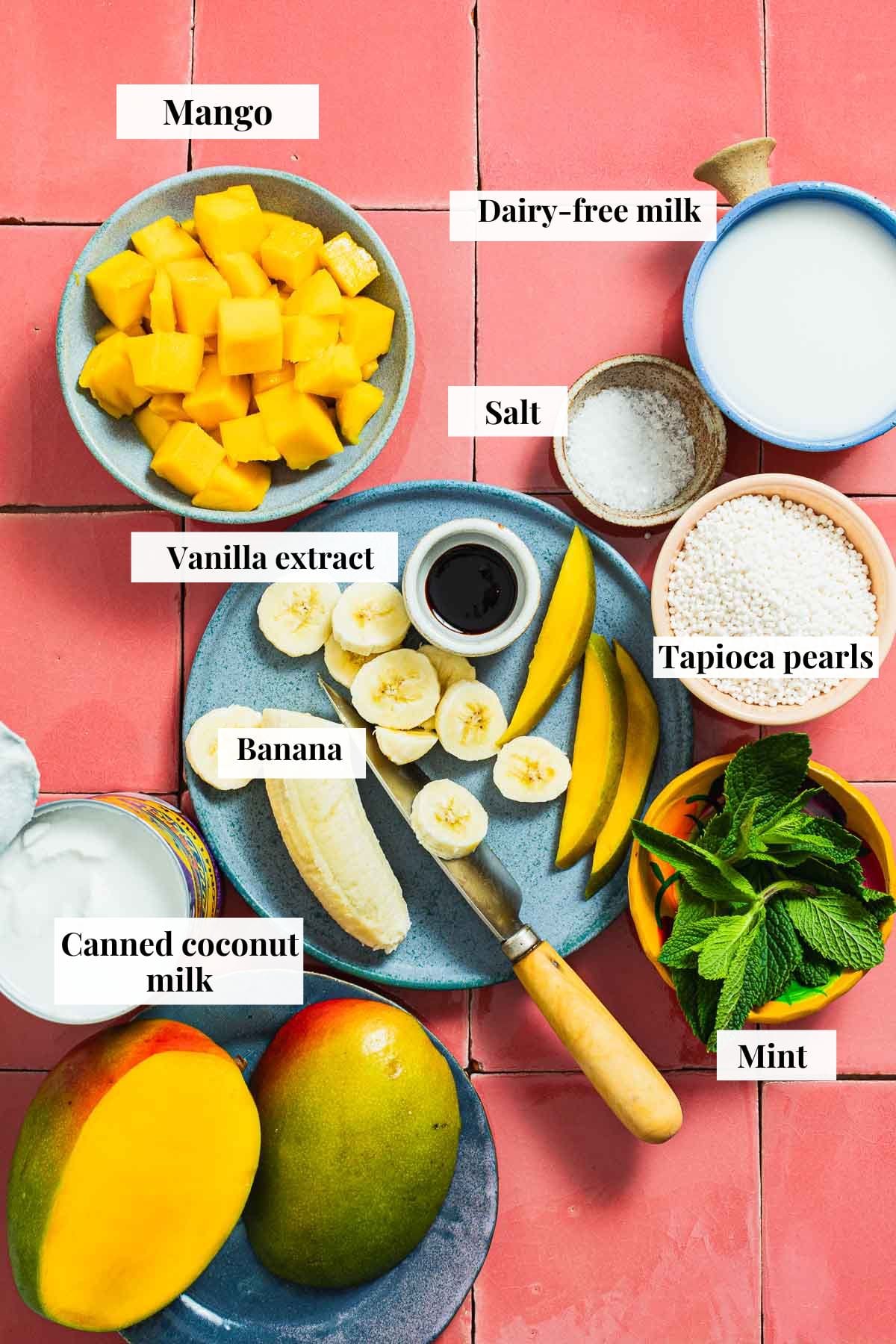
- Mangos: Use any type of mangos you prefer. Make sure they are ripe and ideally chilled.
- Ripe banana: While not a traditional ingredient in this dish, banana slices add fiber, creaminess, sweetness, and tropical flavor that goes well with the other ingredients.
- Dairy-free milk: I used unsweetened soy milk for this Asian mango dessert. This helps to thin the consistency of the coconut milk.
- Canned full-fat coconut milk: Sago is traditionally made with mango and condensed milk, but sago with coconut milk is healthier. It’s super creamy, less sweet, and dairy-free.
- Coarse sea salt
- Sago pearls: Also known as tapioca pearls. I use Bob’s Red Mill brand of small tapioca pearls. (Not Kraft Minute brand, which requires a different cooking process.)
- Vanilla extract to mimic pandan leaves.
- Fresh mint leaves: Optional garnish used for a pop of color and freshness.
Other fruits to use
This tapioca pudding with mango is so versatile! Swap out the mangos or add your favorite fruits for variety. Strawberry compote, blueberry simple syrup, cherries, blackberries, or peaches would be delicious. You can even use frozen fruit to reduce prep time!
How to make mango sago
Making sago dessert is easier than you might think! Cooking the tapioca in coconut milk directly simplifies the cooking process and achieves a creamier texture with less prep. Plus, it infuses the tapioca with more flavor. Here are the instructions for this simple coconut and mango pudding:

- Prepare the fruit: Peel and slice the mango and bananas. Set some of each aside to use as a garnish. Blend the remaining mango into a puree and transfer it to the fridge to chill.
- Make the tapioca and coconut pudding: Heat the milk in a saucepan with a pinch of salt. Add the tapioca and vanilla and cook until translucent. Gently stir in banana rounds.
- Cool and store: Cool the pudding mixture, stirring periodically to prevent clumping. Transfer the cooled pudding to a jar with a lid and store it in the fridge until you’re ready to assemble.
- Assemble and serve: Spoon some mango puree into each glass. Top with tapioca pudding and garnish with mango chunks, banana rounds, and mint leaves. Serve cold.
Tip: To turn this Paleo tapioca pudding into a sago drink, use fewer tapioca pearls or add more milk for a thinner, drinkable consistency.
Tapioca pearls troubleshoot
Cooking tapioca pearls is very easy! Here are some common questions and helpful tips, especially if it’s your first time. If you have any questions not covered here, please leave a comment below and I’ll do my best to help!
- Why is my sago clumping?
- You need to stir the sago pearls periodically to prevent them from clumping in the liquid. It’s important not to cook the pearls in cold water or milk. Add them only to simmering water or milk to keep them from melting together.
- Why are my tapioca pearls hard?
- The pearls weren’t cooked long enough. They should turn translucent, indicating they are soft enough to eat. It’s okay if some pearls have white dots in the center.
- Why did my tapioca pearls dissolve when cooked?
- The pearls were either cooked too long or the liquid was boiling too rapidly. Make sure to simmer the pearls instead of boiling them.
Make ahead, store, and freeze
Make-ahead: You can make the mango puree and the tapioca pudding a day ahead of serving. Store them separately in the fridge. For the best texture, I recommend enjoying it the same day.
Stopping tapioca pearls from turning mushy
Refrigerate vs. Freezing:
- Fridge: Keep leftover pudding in the fridge and consume within three days. The tapioca pearls will continue to expand and soften over time. While the flavor remains unchanged, the pearls can become mushier after being stored overnight in the fridge. Thin it with milk before serving if needed.
- Freezer: The best way to prevent cooked sago pearls from turning mushy is to freeze them. Divide the pudding into individual serving quantities and store in the freezer for up to two months. Depending on the thickness of the block, it might take a full 24 hours to defrost. Once defrosted, the sago pearls will soften and become a little chewy again.
Helpful tips
- Expansion of Tapioca Pearls: Tapioca pearls expand significantly during the cooking process. If it seems there’s too much milk in the pot initially, don’t panic. The pearls will soak up more milk as the dessert cools down.
- Warm the Milk First: Do not add the tapioca pearls before the milk has warmed up, or the pearls will melt and congeal together.
- Avoid Instant Tapioca: Don’t use Kraft’s Minute Tapioca pearls for pudding. These are instant pearls that require different cooking steps.
- Stir Frequently: Stir the sago pearls periodically while cooking to prevent clumping. This ensures they cook evenly and maintain their texture.
- Simmer, Don’t Boil: Keep the heat low when cooking the tapioca pearls. Boiling them too rapidly can cause them to dissolve or turn mushy.
- Check for Doneness: The sago pearls are ready when they turn translucent. It’s okay if some have small white dots in the center, indicating they are perfectly cooked.
- Cool Evenly: After cooking, let the pudding cool for 30 minutes to 1 hour. Stir gently from bottom to top during cooling to prevent the tapioca from settling and to ensure an even texture.
- Proper Storage: Store leftover pudding in the fridge and consume it within three days. If the pudding thickens too much, thin it with a bit of milk before serving.
- Freeze for Longevity: For longer storage, freeze the pudding in individual servings. Defrost overnight in the fridge for the best texture, as this helps prevent the pearls from turning mushy.
FAQs
Technically, no. Sago comes from the sago palm, while tapioca is from cassava root. However, the terms sago and tapioca pearls are often used interchangeably in desserts.
Sago can last up to three days in the fridge. It will thicken and turn harder over time, so thin it with milk and let it sit at room temperature for a few minutes before serving.
Small tapioca pearls are a common substitute for sago. For a low-carb alternative, chia seeds offer a similar consistency and texture.
Absolutely! In colder months, try serving this mango and sago dessert warm without the mango puree for a cozy treat.
More Asian vegan desserts
If you enjoy this sago coconut pudding with mango, please take a look at some of my other Asian-inspired dairy-free and gluten free desserts that are perfect for summertime!
- Iced matcha mango tea with matcha, mango orange juice, fresh kiwi, and sparkling water.
- Black sesame ice cream made with coconut milk and homemade black sesame paste.
- Dairy-free fudge pops are rich, creamy, and low-carb—no ice cream maker or blender needed.
- Coconut sticky rice with mango is a popular Thai dessert with glutinous sweet rice, sweet mangoes, and coconut sticky rice sauce!
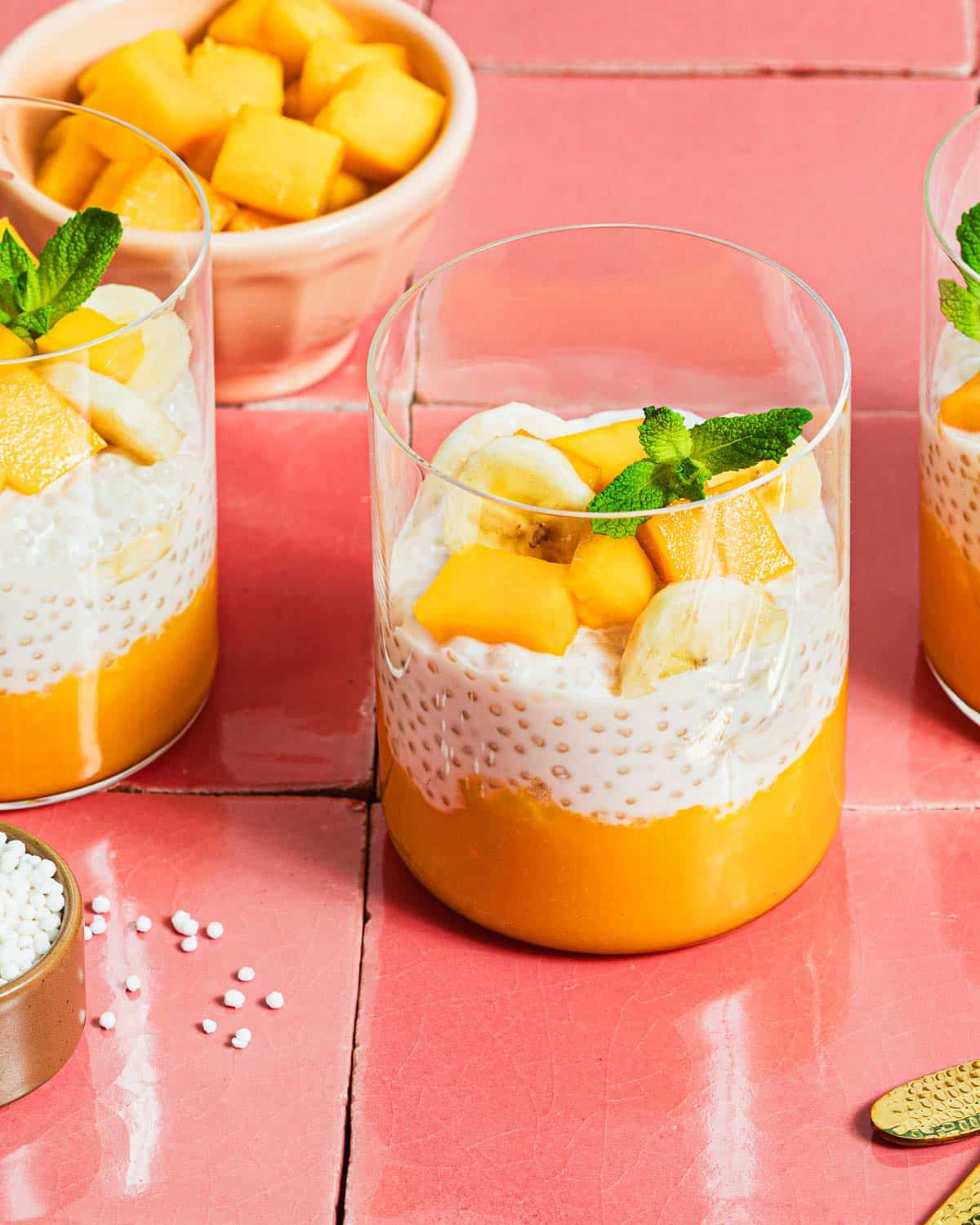

Mango sago recipe
Video
Ingredients
- 2 whole ripe mangos, best chilled in the fridge
- 1 medium ripe banana
- 1 cup dairy-free milk, unsweetened (I use soy milk)
- 14 oz canned full fat coconut milk
- A pinch coarse sea salt, or more to taste
- 5 tbsp sago pearls, also knowns small tapioca pearls, see notes
- 1 tsp vanilla extract
- A few sprigs mint leaves, garnish, optional
Instructions
Preparation of Fruits:
- Mangos: Peel the mangos, reserve a few slices for garnish, and dice them into cubes. Puree the majority remaining mango and store both separately in the fridge.
- Banana: Peel and slice the banana into small rounds. Reserve a few slices for garnish and store these in the fridge. Most of the banana will be used later in the cooking process.
Making the tapioca pudding:
- Heat the Milks: In a medium saucepan, combine milk, canned coconut milk, and a pinch of salt. Simmer over medium heat to warm up the milk for about 4-5 minutes, stirring often with a wooden spoon to incorporate the coconut cream. Keep an eye on the mixture to prevent it from boiling over.
- Add Tapioca and Vanilla: Add tapioca pearls and vanilla extract. Reduce the heat to low and continue stirring periodically to prevent the pearls from clumping. Cook for 6-8 minutes, until the pearls soften and start to turn translucent. The mixture will be quite milky at this point, which is normal.
- Incorporate Banana: Add the reserved banana slices, stirring gently over low heat for an additional 3 minutes. Try to keep the banana pieces intact. The mixture will thicken slightly but will still be somewhat runny.
Cooling and Storing:
- Cooling: Turn off the heat and remove the pot from the stove. Let the pudding cool for about 30 minutes to 1 hour. During this time, gently stir the pudding periodically from bottom to top to help it cool evenly. Avoid crushing the tapioca pearls and banana slices.
- Storing: Once cooled, transfer the pudding to a sealed jar and store in the fridge. The pearls will continue to expand and absorb the milk. The pudding is best enjoyed the same day for optimal texture.
Serving:
- Assemble the Dish: To serve, spoon a few tablespoons of mango puree into each serving glass. Top with a generous amount of tapioca pudding. Garnish with the reserved mango and banana slices, and mint leaves. Serve cold for the best taste.
Notes
- Thicker consistency: Use 6 tablespoons tapioca pearls; Thinner consistency: Use 5 tablespoons.
- Brand: I use Bob’s red mill small tapioca pearls. Not instant tapioca made from Kraft Minute.
- Texture and Consistency: Initially, the pudding has a consistency closer to porridge than Western-style pudding. It thickens significantly upon cooling or chilling.
- Sago Pearls: Best enjoyed the same day they are made, as the pearls continue to expand and soften over time. While the flavor remains unchanged, the pearls can become mushier after stored overnight in the fridge.
- Storage: Keep leftover pudding in the fridge and consume within three days. The texture will thicken further; thin it with milk and let it sit at room temperature for a few minutes before serving.
- Freeze: The sago pudding freezes well. Divide it into individual servings for easy defrosting. Defrost overnight in the fridge; thicker blocks may take up to 24 hours. Once defrosted, the sago pearls will become soft and slightly chewy again. This method helps prevent the pearls from turning mushy if you can’t finish the batch within 2-3 days.
- Serving Suggestion: In colder months, consider serving the pudding warm without the mango puree for a cozy treat.
Nutrition
Made a dish and love it? Please remember to rate the recipe and leave a comment in the comment section below! It helps my blog grow organically so I can continue sharing free and awesome content with you. Thank you!


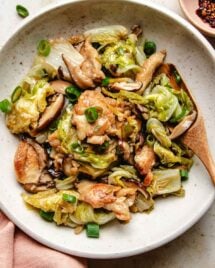

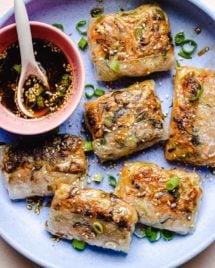
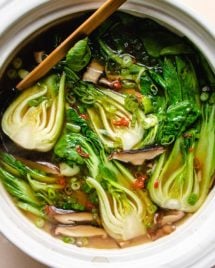


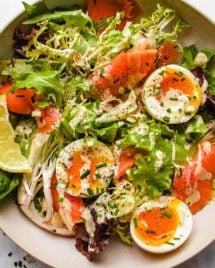
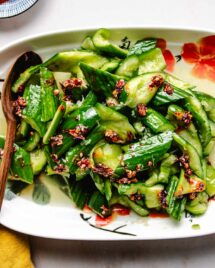
This was delicious and refreshing. Can’t wait to make it for my health conscious grandkids. But I think the 1 teaspoon of salt was an error. The initial pinch was just right. Good job.
Thanks so much. You are right. I adjusted the quantity back to a pinch of salt since that’s what it’s written in the recipe. :))
I made this as a Father’s Day treat after dinner and the whole family loved it!
Wonderful! Thank you! So happy to hear.
Could you suggest a replacement for the bananas? I avoid them due to migraines…thank you! This pudding looks delicious!
Try without the bananas and use less milk. The consistency might be a bit thinner. It’ll still be delicious with the mango puree!
I made this recipe for my family and everyone LOVE it! It’s easy to make and the taste is creamy delicious. I love that it has no added sugar and it tastes so yummy. Thank you!!
Thanks so much!